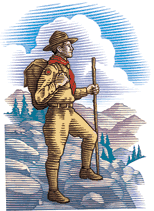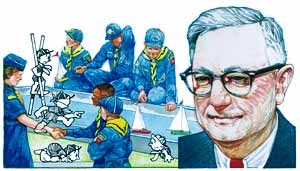![]() May-June 2002
May-June 2002


Looking 'Out There' for Ideas That Work
By Robert Peterson
Illustration by Joel Snyder
O. W. (Bud) Bennett oversaw the huge influx of Baby Boomers into Cub Scouting in the post-World War II decades and supervised an overhaul of the program in the 1960s.

Cub Scouting grew steadily and quite briskly from its birth in 1930 through the World War II years. But it really took off in the mid-1950s when the Baby Boomers began reaching Cub Scout age. Enrollment grew by 200,000 or more a year.
Fortunately, Cub Scouting had a dynamic leader in O. W. (Bud) Bennett, who served as national director of Cub Scouting from 1952 to 1970, the longest tenure to date of anyone in that key position. Bennett, whose first name was Orville—a fact not known to some of his associates—was friendly, unassuming, and humorous, a product of small-town America who never lost the common touch.
He wanted to see for himself
Bud Bennett was no deskbound leader. He wanted to see for himself what was happening in packs across the country.
John C. Horn, project chairman for the preparation of the book History of Cub Scouting, remembered: "He saw the thousands of Cub Scout packs active in various parts of the nation as one vast but diversified laboratory where new ideas and programs could be developed and tested."
Often Bennett would tell an assistant director of the division, 'Let's drop things here at the office and see what's going on out there.'" Off they would go. Bennett wanted to talk with Cub Scout pack leaders, not just the local professional Scouters, to see what worked and what didn't. His enthusiasm for the program was infectious and led to hundreds of friendships with volunteer Scouters in every part of the nation.
Developing good programs
Dave Hoover, vice chairman of the National Cub Scouting Committee during Bennett's service, said: "One of Bud Bennett's biggest assets was his relationship with the field. He was acquainted with Cub Scout leaders in every council across the nation, and it was a mutually advantageous friendship. One of the truisms that Bud knew and practiced was that there are more good programs 'out there' than he [could ever develop at the national level], and the challenge was to develop them where they were."
Hoover was a pack committee chairman when he first met Bud Bennett, and his pack was experimenting with a special den for 10-year-old Lion Cub Scouts. It was an early test of what would later become Webelos Scouting.
"The biggest supporter was Bud himself, who added his own ideas to make it an even better program," Hoover said.
Bud Bennett was a talented cartoonist. His stylized drawings showing Cub Scouts at work and play entertained a couple of generations of boys and leaders in Cub Scouting's activity books, training filmstrips, posters, and leaflets.
The Cub Scout program was broadened during Bennett's tenure with the introduction of the pinewood derby and the raingutter regatta as annual program features. And the blue and gold dinner, which had been born during the 1940s, became the biggest social event of the Cub Scout year on Bennett's watch.
Something for older Cub Scouts
There was rapid growth in Cub Scouting enrollment, but the dropout rate was high, apparently because the advancement program from Wolf to Bear to Lion lacked variety.
After careful study, the whole advancement trail was revised under Bennett's leadership in 1967. The major change was creation of Webelos Scouting, with a new advancement plan for the oldest Cub Scouts. It offered 15 activity badges in such career fields as engineering and geology and such avocations as sports and aquatics.
Bennett retired from professional Scouting in 1970. He had come a long way from his birth in the village of Redfield, S.D., in 1908. He graduated from the University of Minnesota and the Minneapolis Advertising and Display School. He spent 14 years in advertising and sales promotion, while serving as a volunteer assistant Scoutmaster and commissioner for Cub Scouting.
Bud Bennett became a professional Scouter in 1941, serving local councils in Toledo and Middletown, Ohio, before going to the national office in 1947 as assistant to the director of Scouting Services. In 1949, he became director of Exploring and shifted to the Cub Scout division three years later.
After his retirement, Bennett dipped his toe into local politics in Piscataway Township, N.J. An indication of his popularity is shown by the fact that Bennett, a Republican, was named Piscataway's interim mayor by the Democratic-controlled Township Council when the incumbent resigned. He died of an apparent heart attack on Aug. 7, 1974. "Mr. Cub Scout" was 66.
Robert Peterson is a Scouting magazine contributing editor.
May-June 2002 Table of Contents
Copyright © 2002 by the Boy Scouts of America. All rights thereunder reserved; anything appearing in Scouting magazine or on its Web site may not be reprinted either wholly or in part without written permission. Because of freedom given authors, opinions may not reflect official concurrence.
| The Boy Scouts of America | http://www.scouting.org |